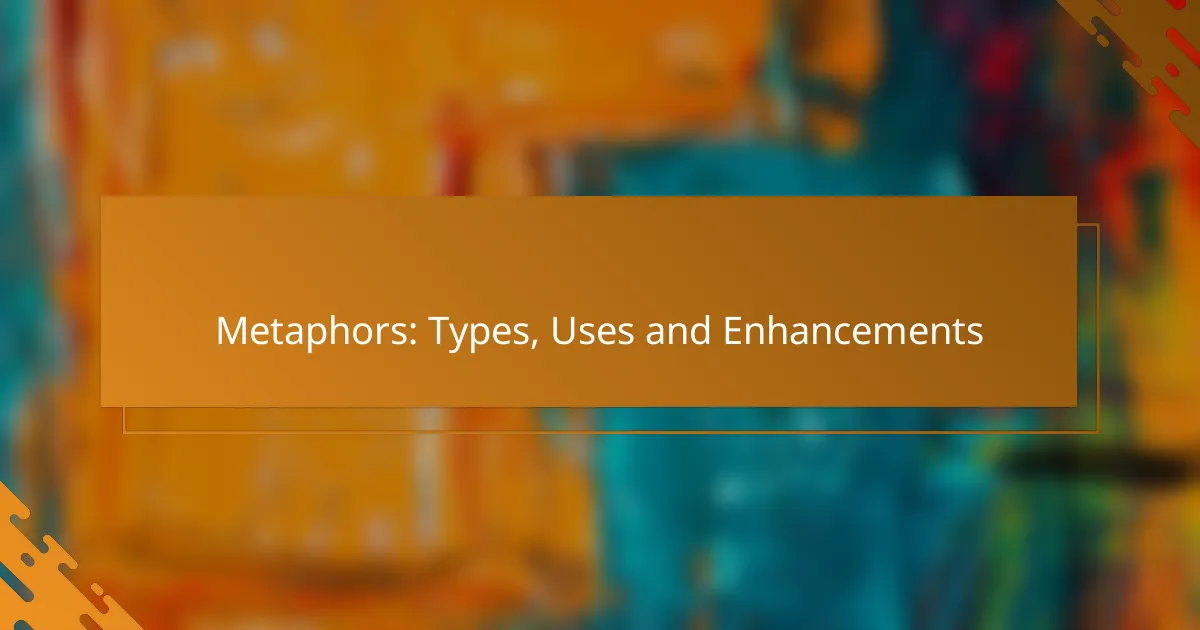Metaphors play a crucial role in enhancing communication by creating relatable imagery that resonates with audiences. They simplify complex ideas, making messages more engaging and memorable, particularly in marketing and advertising contexts. By categorizing metaphors and understanding their distinct purposes, communicators can forge deeper connections and convey brand messages more effectively.
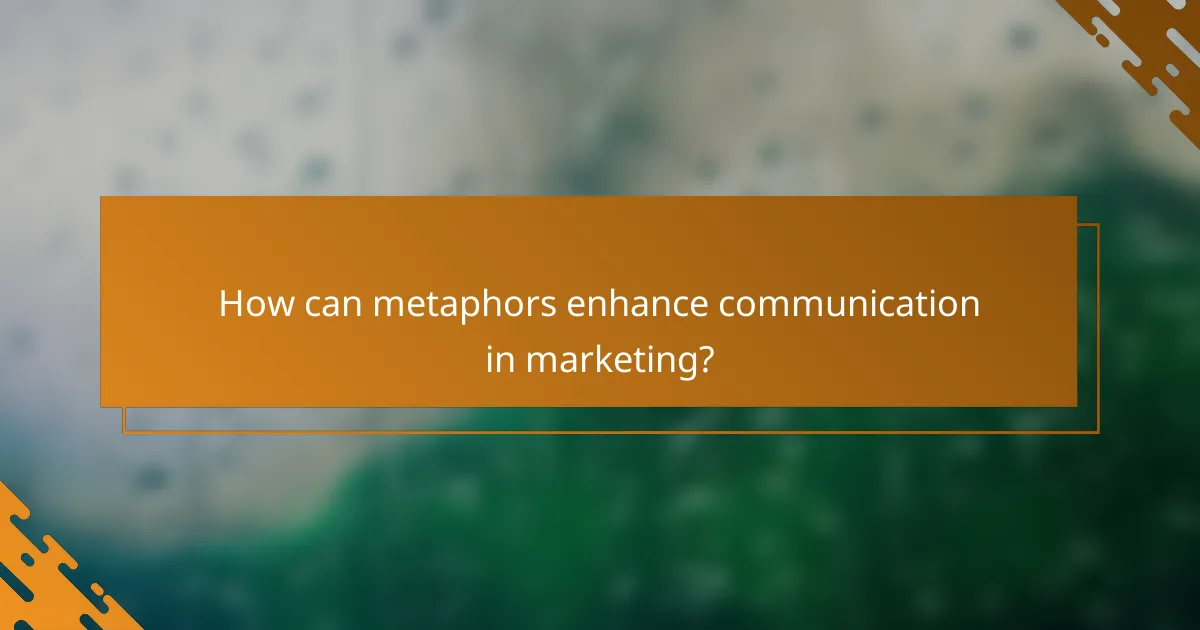
How can metaphors enhance communication in marketing?
Metaphors can significantly enhance communication in marketing by creating relatable imagery that resonates with audiences. They simplify complex ideas, making messages more engaging and memorable, which ultimately drives consumer action.
Improved audience engagement
Metaphors capture attention by connecting unfamiliar concepts to familiar experiences. This connection can evoke emotions and stimulate curiosity, encouraging audiences to engage more deeply with the content. For example, describing a product as a “lifesaver” can create a sense of urgency and importance.
Using metaphors in marketing campaigns can also foster a sense of community among consumers. When people relate to the imagery, they are more likely to share the message, amplifying its reach through word-of-mouth and social media.
Stronger brand messaging
Metaphors help convey a brand’s core values and identity in a concise manner. By using a consistent metaphor across various marketing channels, brands can create a unified message that reinforces their positioning. For instance, a tech company might use the metaphor of “unlocking potential” to emphasize innovation and empowerment.
Additionally, strong metaphors can differentiate a brand from its competitors. A unique metaphor can make a brand more recognizable and relatable, helping it stand out in a crowded market. Brands should ensure that their chosen metaphors align with their target audience’s values and experiences.
Increased memorability
Metaphors enhance memorability by creating vivid mental images that stick in consumers’ minds. When a message is framed in a metaphorical context, it becomes easier to recall, which is crucial in a competitive marketplace. For example, a campaign that likens a service to a “smooth ride” can help consumers remember the ease of use associated with the service.
To maximize memorability, marketers should focus on metaphors that are simple and relatable. Overly complex or obscure metaphors may confuse rather than clarify, diminishing their effectiveness. Testing different metaphors with target audiences can help identify the most impactful imagery for a campaign.
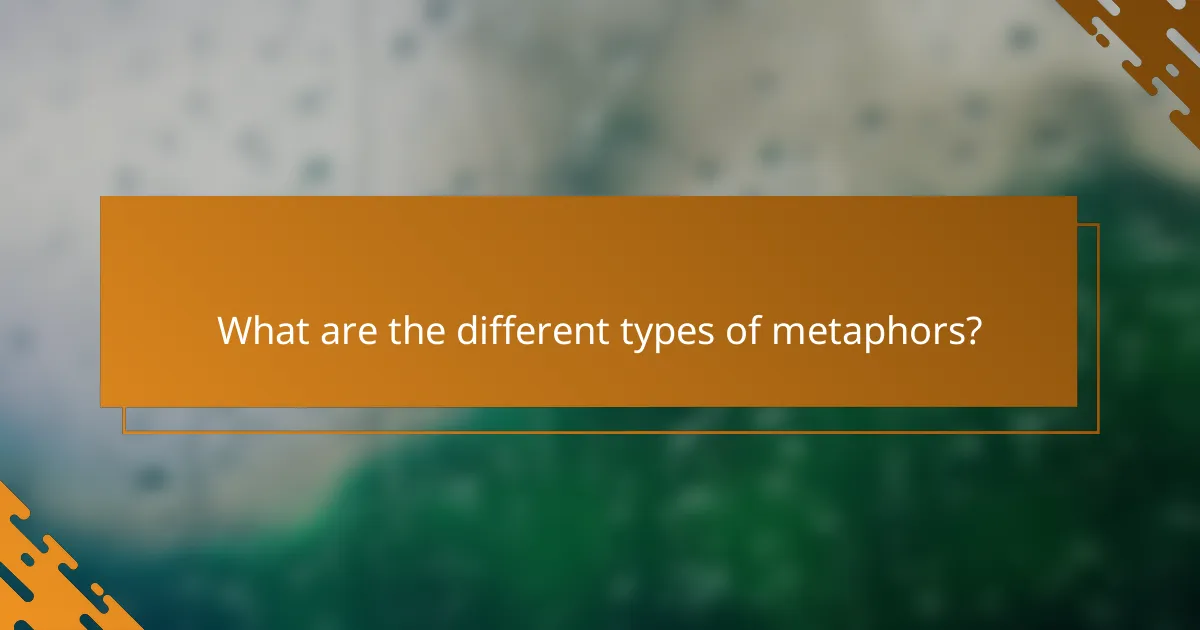
What are the different types of metaphors?
Metaphors can be categorized into several types, each serving distinct purposes in communication. Understanding these types enhances the effectiveness of language by creating vivid imagery and deeper connections.
Conceptual metaphors
Conceptual metaphors are foundational frameworks that shape how we understand abstract ideas through more concrete terms. For example, viewing time as money—“spending time” or “saving time”—helps convey the value we place on time management. These metaphors influence our thoughts and behaviors in everyday situations.
When using conceptual metaphors, consider their cultural context, as interpretations may vary. A metaphor that resonates in one culture might not have the same impact in another, so it’s essential to tailor your language to your audience.
Visual metaphors
Visual metaphors use imagery to convey ideas, often found in art, advertising, and media. They create associations between two unrelated elements, enhancing understanding through visual representation. For instance, a broken chain might symbolize freedom or liberation, effectively communicating a complex message in a simple image.
To effectively employ visual metaphors, ensure that the imagery aligns with the intended message. Misleading visuals can confuse the audience, so clarity and relevance are key. Consider testing visuals with a sample audience to gauge their interpretations before finalizing your design.
Extended metaphors
Extended metaphors develop a comparison over several lines or throughout an entire piece of writing, deepening the connection between the two concepts. A classic example is Shakespeare’s use of the world as a stage, where life events are likened to performances. This technique allows for richer exploration of themes and ideas.
When crafting extended metaphors, maintain consistency in the imagery to avoid losing the audience’s understanding. It’s beneficial to revisit the central metaphor periodically within the text to reinforce the connection and enhance the overall impact of your message.
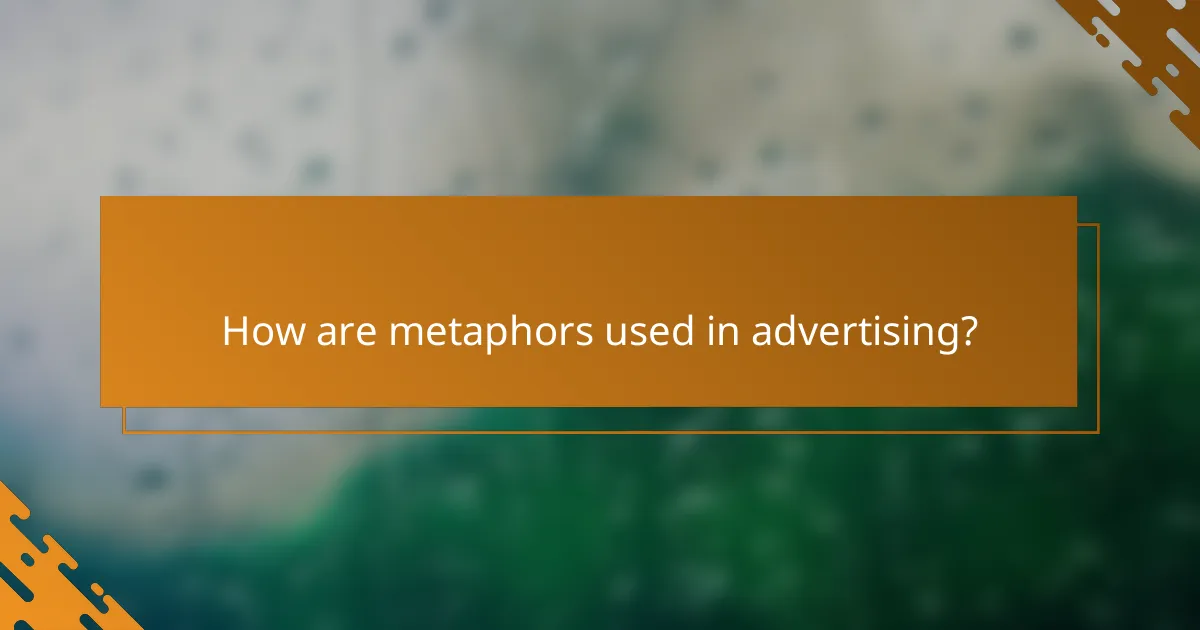
How are metaphors used in advertising?
Metaphors in advertising create vivid imagery that helps consumers connect with products on a deeper level. By comparing a product to something familiar, advertisers can convey complex ideas quickly and effectively, enhancing brand messaging.
Creating relatable narratives
Metaphors help craft narratives that resonate with consumers by linking products to relatable experiences. For instance, a car advertisement might compare driving to a journey through life, making the vehicle feel like a companion in personal adventures. This storytelling approach fosters a connection between the brand and the audience.
Using metaphors in narratives allows advertisers to present their products as integral to everyday life, making them more appealing. A common strategy is to depict a product as a solution to a problem, such as a cleaning product being likened to a superhero that saves the day from dirt and grime.
Evoking emotional responses
Metaphors can effectively evoke emotions by tapping into shared feelings and experiences. For example, a skincare brand might use the metaphor of a “shield” to describe its product’s protective qualities against environmental stressors, instilling a sense of safety and care in potential customers.
Emotional engagement is crucial in advertising, as it can significantly influence purchasing decisions. Advertisers often use metaphors that resonate with feelings of nostalgia, happiness, or aspiration, creating a memorable impression that encourages brand loyalty.
Highlighting product benefits
Metaphors can succinctly highlight product benefits by making abstract concepts tangible. For instance, a financial service might describe its offerings as a “bridge” to financial security, simplifying complex ideas about savings and investments for consumers.
When using metaphors to emphasize benefits, clarity is key. Advertisers should ensure that the metaphor directly relates to the product’s advantages, avoiding confusion. A well-chosen metaphor can effectively communicate value, making it easier for consumers to understand why they should choose a particular product over competitors.

What are the best practices for using metaphors in content?
Effective use of metaphors in content enhances understanding and engagement. To maximize their impact, consider your audience, ensure clarity, and incorporate culturally relevant references.
Know your audience
Understanding your audience is crucial when using metaphors. Different groups may interpret metaphors in various ways based on their backgrounds, experiences, and cultural contexts.
For example, a metaphor about sports may resonate well with a younger demographic but might confuse older readers who are less familiar with the sport. Tailor your metaphors to align with the interests and knowledge of your target audience.
Maintain clarity
Clarity is essential when using metaphors; they should enhance comprehension rather than obscure meaning. Avoid overly complex or obscure metaphors that may confuse readers.
For instance, instead of saying “navigating the labyrinth of regulations,” you might say “understanding the rules.” This keeps the message clear while still conveying the idea of complexity.
Use relevant cultural references
Incorporating culturally relevant references in your metaphors can create a stronger connection with your audience. Metaphors that draw from familiar cultural touchstones are more likely to resonate.
For example, using a metaphor related to a popular movie or local tradition can make your content more relatable. However, ensure that the references are current and widely understood within your target demographic to avoid alienating any readers.
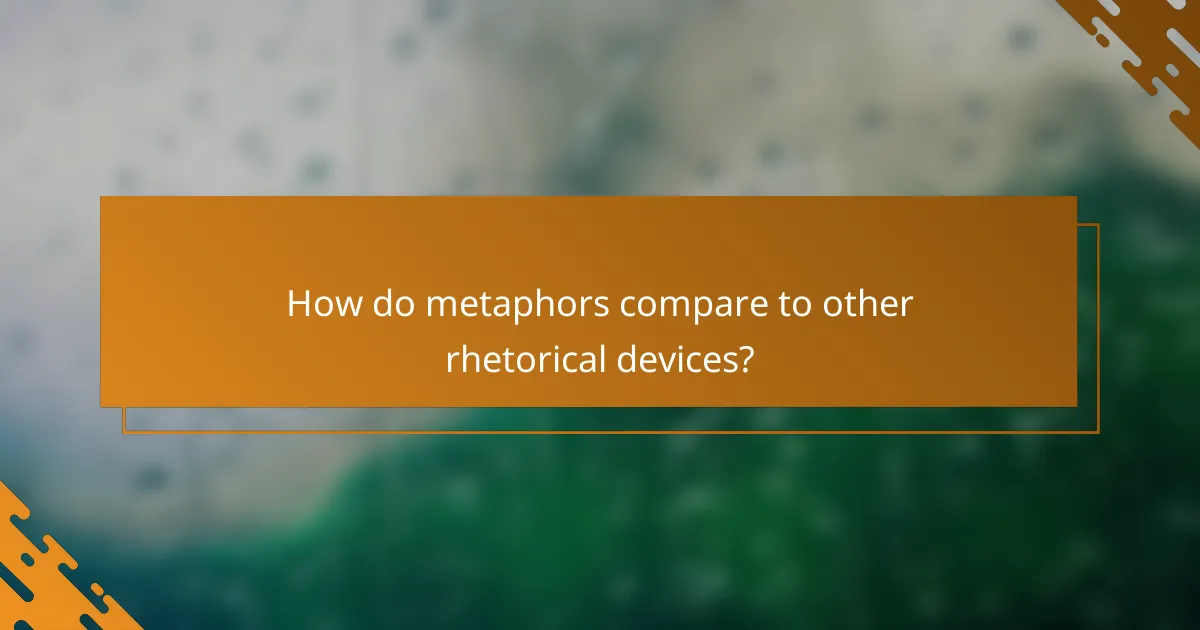
How do metaphors compare to other rhetorical devices?
Metaphors are distinct from other rhetorical devices in that they create direct comparisons between unrelated subjects, enhancing understanding and imagery. Unlike similes and analogies, metaphors imply a deeper connection, often evoking more emotional responses.
Metaphors vs. similes
Metaphors and similes both create comparisons, but similes use “like” or “as” to highlight similarities explicitly. For example, saying “her smile is like sunshine” is a simile, while “her smile is sunshine” is a metaphor. This difference can affect the strength and immediacy of the imagery presented.
When using similes, the comparison is often perceived as less intense than with metaphors. Writers should choose between them based on the desired impact; metaphors can create more vivid imagery but may require more context for clarity.
Metaphors vs. analogies
While both metaphors and analogies draw comparisons, analogies explain a concept by illustrating how two different things are alike in a specific way. For instance, saying “life is a journey” is a metaphor, whereas “life is like a journey because it has ups and downs” is an analogy. Analogies often provide more context and reasoning behind the comparison.
In practical writing, use analogies when you need to clarify complex ideas, while metaphors can enhance emotional resonance. Be cautious not to overcomplicate your message; choose the device that best fits your audience’s understanding and the context of your writing.
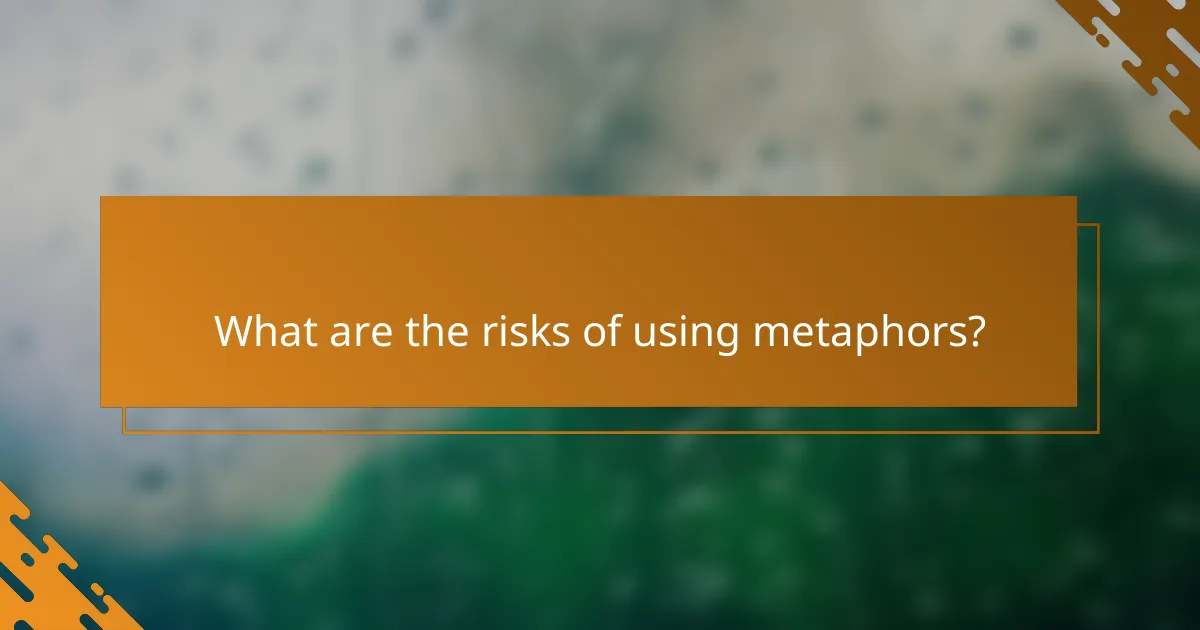
What are the risks of using metaphors?
Using metaphors carries several risks, including potential misinterpretation and the possibility of complicating messages. These risks can lead to confusion and hinder effective communication, making it essential to consider the audience’s perspective when employing metaphors.
Misinterpretation by the audience
One of the primary risks of using metaphors is that the audience may misinterpret their intended meaning. Metaphors rely on shared cultural references and experiences; if these are absent, the metaphor can become unclear or misleading. For instance, a metaphor like “the world is a stage” may resonate with some but confuse others unfamiliar with theatrical concepts.
To mitigate this risk, ensure that the metaphors used are relevant and easily understood by the target audience. Testing metaphors with a small group can help identify potential misunderstandings before broader communication.
Overcomplication of messages
Metaphors can sometimes overcomplicate messages, making them harder to grasp. When a metaphor is too elaborate or abstract, it can distract from the main point rather than enhance understanding. For example, using a complex metaphor in a technical report may obscure critical data and lead to misinterpretation.
To avoid this pitfall, keep metaphors simple and directly related to the subject matter. Aim for clarity by using straightforward language and ensuring that the metaphor adds value rather than confusion. A good rule of thumb is to limit metaphorical language in formal or technical contexts where precision is paramount.
